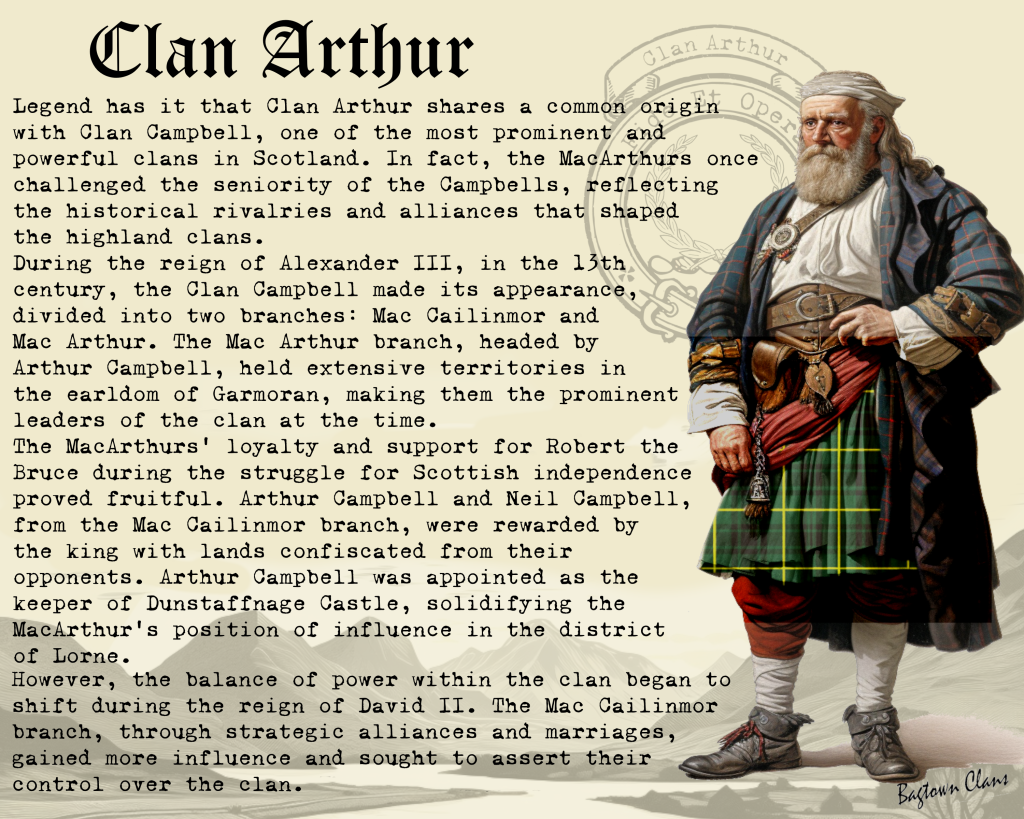Clan Arthur Crest
|
|
CREST: Two laurel branches in orle Proper MOTTO: Fide et opera TRANSLATION: By fidelity and labor VARIATIONS: MacArthur, McArthur |
| Legend has it that Clan Arthur shares a common origin with Clan Campbell, one of the most prominent and powerful clans in Scotland. In fact, the MacArthurs once challenged the seniority of the Campbells, reflecting the historical rivalries and alliances that shaped the highland clans.
During the reign of Alexander III, in the 13th century, the Clan Campbell made its appearance, divided into two branches: Mac Cailinmor and Mac Arthur. The Mac Arthur branch, headed by Arthur Campbell, held extensive territories in the earldom of Garmoran, making them the prominent leaders of the clan at the time. The MacArthurs’ loyalty and support for Robert the Bruce during the struggle for Scottish independence proved fruitful. Arthur Campbell and Neil Campbell, from the Mac Cailinmor branch, were rewarded by the king with lands confiscated from their opponents. Arthur Campbell was appointed as the keeper of Dunstaffnage Castle, solidifying the MacArthur’s position of influence in the district of Lorne. |
|
 |
|
| Purchase @ Redbubble Purchase @ Amazon.com Purchase @ Amazon.co.uk |
|
| However, the balance of power within the clan began to shift during the reign of David II. The Mac Cailinmor branch, through strategic alliances and marriages, gained more influence and sought to assert their control over the clan. The Mac Arthur branch, though they still held some lands, lost their preeminent status within the clan.
Tragedy struck Clan Arthur in 1427 when James I held a parliament at Inverness and summoned the Highland chiefs. Iain MacArthur, the chief of the MacArthurs, was one of the unfortunate chiefs who were beheaded by the king. Known as a great prince among his people and a leader of a thousand men, his execution marked a turning point for the clan. Following the execution of Iain MacArthur, the MacArthurs lost most of their lands, retaining only Strachur and portions of Glenfalloch and Glen Dochart in Perthshire. From this point forward, the Mac Cailinmor branch of the Campbells emerged as the leaders of the clan, while the MacArthur influence waned. In the 18th century, Clan Arthur faced a significant setback when Patrick MacArthur, the chief of Clan Arthur, passed away without a male heir. The official title of Chief of Clan Arthur ceased to exist, leaving the clan leaderless for over two centuries. However, in 1991, the clan made a breakthrough. Genealogical research conducted on behalf of Clan Arthur traced the lineage back to the chiefly line of the MacArthurs, the MacArthurs of Tirivadich. Through meticulous investigation, a living descendant, James Edward Moir MacArthur of Milton, was identified. James Edward Moir MacArthur successfully petitioned the Lord Lyon, the heraldic authority in Scotland, to be appointed Clan Commander of Clan Arthur. In 2002, after a hiatus of approximately 230 years, he was recognized as the Chief of Clan Arthur. His inauguration in April 2003 marked a momentous occasion for the clan, restoring a sense of unity and purpose. Today, John Alexander MacArthur of that Ilk, the son of James Edward Moir MacArthur, serves as the current chief of Clan Arthur. As a member of the Standing Council of Scottish Chiefs, he upholds the legacy and traditions of the clan, representing its interests within the Scottish community. |
|
Citations:
|
|

